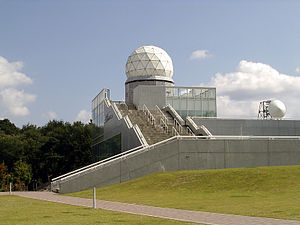
The Mount Fuji Radar System is a historic weather radar system located on the summit of Mount Fuji, Japan. It was completed on August 15, 1964, [1] and is now recorded on the list of IEEE Milestones in electrical engineering. When first built, the Mount Fuji Radar System was the world's highest weather radar (elevation 3,776 metres [12,388 ft]), and could observe major weather phenomena, such as destructive typhoons, at a range of more than 800 kilometres (500 mi). It was designed by the Japan Meteorological Agency and built by Mitsubishi Electric Corporation.
The system is notable for its advances in weather radar technology, remote control, and difficulty of construction, as it required the transport and assembly of some 500 tons of material during mountain's short summer. It operated at a frequency of 2880 MHz, with output power of 1500 kilowatts, and a pulse width of 3.5 microseconds. Its antenna was a circular dish, 5 meters in diameter, of parabolic shape, rotating at either 3 or 5 revolutions per minute, and housed within a 9-meter radome.
The system was decommissioned in 1999, as it was superseded by weather satellites. The dome, radar dish and support equipment were relocated to a purpose-built museum in Fujiyoshida, Yamanashi in 2001. It was replaced by an automated weather system in 2004. [2]
References
- ^ "Rebuilding Japan— a Transitional Process for Mitsubishi, Mitsubishi Public Affairs Committee
- ^ "Mt.Fuji Weather Observatory Transfer to Special Area Meteorological Observatory" 富士山測候所の特別地域気象観測所への移行について. Japan Meteorological Agency (Press Release) (in Japanese). 6 June 2008. Archived from the original on 28 June 2023. Retrieved 28 June 2023.
Further reading
- Mt. Fuji weather radar station on the IEEE Global Milestones Portal
- Tapan K. Sarkar, Robert Mailloux, Arthur A. Oliner, Magdalena Salazar-Palma, Dipak L. Sengupta, History of Wireless, Wiley-IEEE, 2006, pages 470-471. ISBN 0-471-78301-3.
- "About the Interim Summary of the Review Committee for the Effective Use of the Mt. Fuji Weather Observatory Summit Office Building" 富士山測候所山頂庁舎等有効利用検討委員会 中間とりまとめについて (PDF). Japan Meteorological Agency (Press Release) (in Japanese). 25 March 2005. Archived from the original (PDF) on 16 January 2023. Retrieved 28 June 2023.